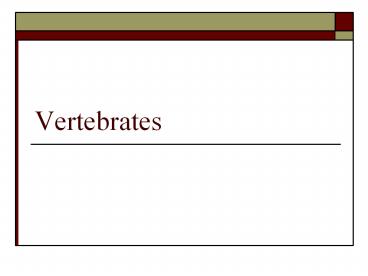Vertebrates - PowerPoint PPT Presentation
1 / 14
Title:
Vertebrates
Description:
Vertebrates Phylum Chordata 4 basic characteristics: Notochord supporting rod dorsally located, below the nerve cord, replaced by vertebral column in most ... – PowerPoint PPT presentation
Number of Views:222
Avg rating:3.0/5.0
Title: Vertebrates
1
Vertebrates
2
Phylum Chordata
- 4 basic characteristics
- Notochord supporting rod dorsally located,
below the nerve cord, replaced by vertebral
column in most chordates - Nerve cord anterior portion becomes brain, rest
spinal cord - Pharyngeal pouches only seen during embryonic
development, gills in aquatic vertebrates. In
humans, 1st pair auditory tubes, 2nd tonsils,
3 and 4th pair thyroid and parathyroid - Postanal tail in embryo if not in adult
3
Nonvertebrate chordates
- Notochord persists in adults
- Lancelets
- marine, few centimeters long
- retain 4 chordate characteristics as adult
- Sea squirts (tunicates)
- live on ocean floor
- squirt water in defense
- Retain gills as adult
4
Vertebrates
- At some stage in life history, have all four
chordate characteristics - Living endoskeleton with vertebral column
- Closed circulatory system
- Paired appendages
- Efficient respiration and excretory
- High degree of cephalization
5
Fishes
- Evolution
- Jawless agnathans, lamprey
- jaws
- Cartilaginous sharks, stingrays
- Bony -
- Lobe finned coelacanths, thought to give rise
to amphibians - Ray finned soldier fish, lionfish, seahorse,
swordfish
6
Fish Characteristics
- Aquatic ectotherms depend on environment to
regulate body temp - Skin covered with scales
- Fins for swimming
- Single loop cardiovascular pathway, 2 chambered
heart - Breath with gills
- Lay eggs
- Swim bladder seen in bony fish, buoyancy
7
Amphibians
- Live on both land and water
- 3 main groups
- Salamanders and newts elongated bodies, long
tails - Frogs and toads - tailless
- Caecilians legless, sometimes sightless, worm
shaped
8
Amphibian characteristics
- Usually tetrapod 4 legged
- Usually lungs in adults
- Metamorphosis
- Smooth and moist skin
- 3 chambered heart
- Ectothermy
- Most lay eggs in water
9
Reptiles
- Amniotic egg evolves
- Extraembryonic membranes protect the embryo,
remove nitrogenous wastes and provide the embryo
with oxygen, food and water - Crocodiles and alligators, turtles, lizards,
snakes, amphisbaenians (worm lizards) and tuataras
10
Reptile characteristics
- Usually tetrapods
- Lungs with expandable rib cage
- Leathery-sheled amniotic egg
- Dry, scaly skin that is impermeable to water
- Ectotherms can lay in sun to maintain a warm
body temperature
11
Birds - Aves
- Some fly, some do not
- Usually classified according to beak and foot
type - Efficient nervous, respiratory, and circulatory
systems.
12
Bird characteristics
- Feathers
- Hard shelled amniotic egg
- 4 chambered heart
- Usually wings for flying
- Air sac
- endothermy
13
Mammals - development
- Monotremes mammals have a cloaca and lay hard
shelled amniote eggs - Duckbill platypus and spiny anteater
- Marsupials begin development inside the female
body and born in a very immature condition, move
to pouch and attach to nipple - Kangaroo, koala, wombat
- Placental mammals dependent on the placenta
(organ of exchange between maternal blood and
fetal blood) - Long dependency on the parents
14
Mammal characteristics
- Body hair
- Differentiated teeth
- Well-developed brain
- Usually live births and newborn dependency
- Mammary glands
- Endothermy
- Internal development































